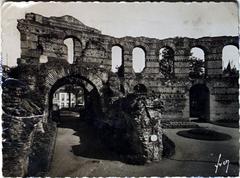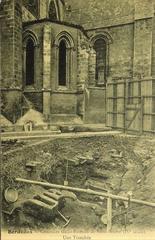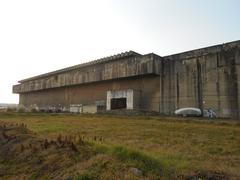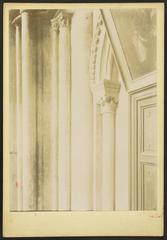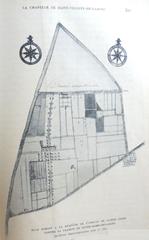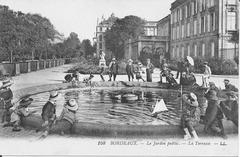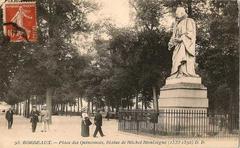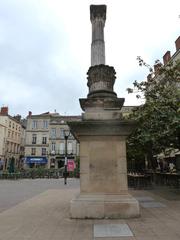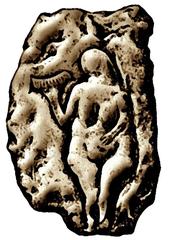Guide to Visiting Porte Dijeaux in Bordeaux, France
Date: 23/07/2024
Introduction
Porte Dijeaux, also known as Porte Dauphine, is one of Bordeaux’s most iconic historical landmarks, steeped in a rich tapestry that dates back to the 18th century. This neoclassical gate stands as a testament to Bordeaux’s transformation from a medieval town into a modern urban center, reflecting the city’s commitment to architectural beauty and historical preservation. Originally constructed between 1748 and 1753 under the direction of architect André Portier, Porte Dijeaux was part of an ambitious urban development plan led by Intendant Tourny to modernize Bordeaux (Explore Porte Dijeaux). Its name, derived from the Latin ‘Jovis,’ meaning Jupiter, hints at its deep-rooted connections to Bordeaux’s Roman past (Porte Dijeaux - Exploring Bordeaux’s Historic Gate). Today, Porte Dijeaux not only serves as a historical monument but also a cultural hub, attracting visitors from around the globe who seek to immerse themselves in the city’s rich heritage. This comprehensive guide aims to provide you with all the essential information needed to make the most of your visit to Porte Dijeaux, including historical insights, visitor tips, and nearby attractions.
Table of Contents
History of Porte Dijeaux
Origins and Early History
Porte Dijeaux, originally known as Porte Dauphine, traces its origins to the Roman era when Bordeaux, then called Burdigala, was a key settlement in the Roman Empire. The name ‘Dijeaux,’ derived from the Latin ‘Jovis,’ referring to Jupiter, hints at the gate’s historical significance and its connection to Bordeaux’s ancient Roman heritage. The gate was built between 1748 and 1753 under the direction of architect André Portier and was part of a broader urban development plan initiated by Intendant Tourny, aimed at modernizing Bordeaux and enhancing its aesthetic appeal.
Architectural Significance
Porte Dijeaux is an exemplary piece of neoclassical architecture, characterized by its symmetrical design and decorative elements. The gate features a central arch flanked by two smaller pedestrian arches, all adorned with intricate carvings and reliefs. The central arch is topped with a pediment, which adds to the gate’s grandeur and elegance.
The use of columns, pilasters, and decorative motifs such as garlands and medallions are indicative of the neoclassical style. The gate’s design not only served a functional purpose but also conveyed a sense of order, harmony, and beauty, which were key principles of the Enlightenment.
Cultural and Historical Significance
Porte Dijeaux holds significant cultural and historical value for Bordeaux. It stands as a testament to the city’s rich history and its evolution over the centuries. The gate has witnessed numerous historical events and has been a silent observer of the city’s transformation from a medieval town to a modern urban center.
During the French Revolution, Porte Dijeaux, like many other historical monuments, faced the threat of destruction. However, it survived and continued to be an important landmark in Bordeaux. The gate has also been a focal point for various cultural and social activities, serving as a gathering place for locals and visitors alike.
Visitor Tips for Porte Dijeaux
Location and Accessibility
Porte Dijeaux is located in the heart of Bordeaux, near the bustling shopping street Rue Sainte-Catherine. The gate is easily accessible by foot, public transport, or bicycle. The nearest tram stop is Gambetta, which is just a short walk away.
Best Time to Visit
The gate can be visited year-round, but the best time to visit is during the spring (April to June) and autumn (September to November) months when the weather is pleasant. Early mornings or late afternoons are ideal for avoiding the crowds and capturing beautiful photographs.
Guided Tours
To gain a deeper understanding of the gate’s history and significance, consider joining a guided tour. Many local tour operators offer walking tours that include Porte Dijeaux as part of their itinerary. These tours provide valuable insights and anecdotes that enhance the visitor experience.
Nearby Attractions
While visiting Porte Dijeaux, take the time to explore nearby attractions such as Place Gambetta, a beautiful square with gardens and fountains, and the Grand Théâtre de Bordeaux, an architectural masterpiece and cultural hub. The nearby Rue Sainte-Catherine is also worth a visit for its vibrant shops, cafes, and restaurants.
Practical Information
- Opening Hours: Porte Dijeaux is an open-air monument and can be visited at any time of the day. However, the surrounding shops and cafes have specific opening hours, typically from 10:00 AM to 7:00 PM.
- Admission Fee: There is no admission fee to visit Porte Dijeaux. It is a public monument and accessible to everyone.
- Photography: The gate is a popular spot for photography, especially for capturing its architectural details and the surrounding urban landscape. Early morning or late afternoon light provides the best conditions for photography.
- Safety and Etiquette: While visiting, be mindful of the local customs and etiquette. Avoid littering and respect the historical significance of the monument. The area around Porte Dijeaux is generally safe, but it’s always advisable to stay aware of your surroundings, especially during late hours.
- Accessibility: Porte Dijeaux is accessible to people with disabilities. The nearby streets and pathways are generally wheelchair-friendly, and there are ramps available at key points. For more specific accessibility information, it’s recommended to check with local tourism services.
Frequently Asked Questions (FAQ)
Q: What are the visiting hours for Porte Dijeaux?
A: Porte Dijeaux is an open-air monument and can be visited at any time of the day.
Q: Is there an admission fee for Porte Dijeaux?
A: No, there is no admission fee. It is a public monument and accessible to everyone.
Q: Are guided tours available for Porte Dijeaux?
A: Yes, many local tour operators offer guided walking tours that include Porte Dijeaux as part of their itinerary.
Q: What are some nearby attractions to Porte Dijeaux?
A: Nearby attractions include Place Gambetta, the Grand Théâtre de Bordeaux, and Rue Sainte-Catherine.
Conclusion
Porte Dijeaux is more than just an ancient city gate; it is a symbol of Bordeaux’s enduring legacy. From its neoclassical architecture to its historical and cultural significance, this landmark offers a unique glimpse into the city’s past while continuing to be a vital part of its present. Visitors can explore the gate at any time, free of charge, making it an accessible and enriching experience for all. The surrounding areas, including Place Gambetta and Rue Sainte-Catherine, further enhance the visit, offering a blend of historical beauty and modern vibrancy (A Complete Guide to Visiting Porte Dijeaux). Whether you’re a history enthusiast, a cultural explorer, or simply a curious traveler, Porte Dijeaux promises a memorable and insightful journey into Bordeaux’s storied past. For additional information and travel tips, consider exploring other resources and guides to fully appreciate the historical richness and architectural splendor of this iconic monument (Bordeaux Tourism website).
